#metatags
Text
Fruits Basket Ao3 Media Tags Poll Results, and Some Thoughts on Ao3 Fandom Tag Wrangling
Over the past few weeks, I've put out a few polls to find out how other Ao3 users are using the different Fruits Basket media tags. Here are the results!
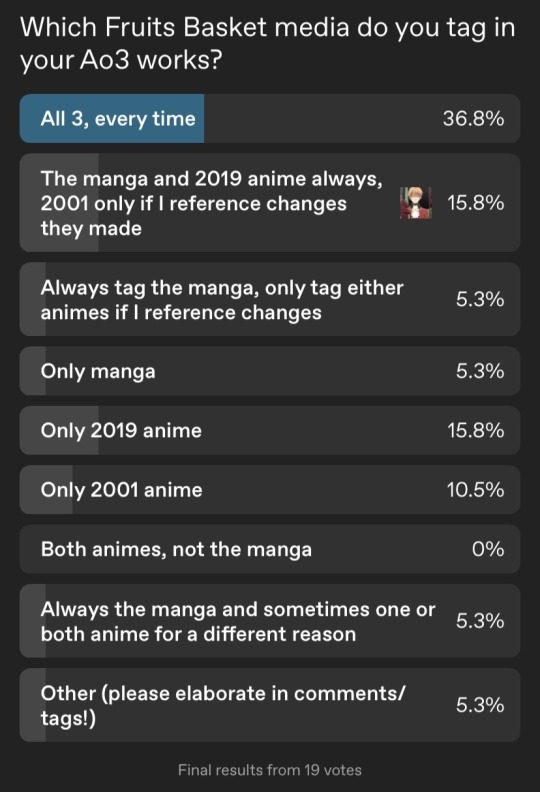


(Obligatory disclaimer that a tumblr poll by one user with fewer than 50 followers is hardly scientific data)
For writers, it looks like most of us (52.6%, or 10 out of 19 respondents) are tagging more than one media type every time, and an additional 10.5% are sometimes tagging multiple media types (total of 63.1%, or 12 out of 19). 31.6%, or 6 out of 19, are only tagging one media type. I believe the person who selected "other" hasn't posted Fruits Basket work yet, but indicated they'd be likely to tag all three.
Of note: even though far more works are tagged with the manga tag than either anime, including when I excluded crossovers, the 2019 anime had the most works updated since January 1 of this year excluding crossovers at 25 (vs 4 for the 2001 anime, and 12 for the manga).
For readers, it looks like most of us (46.4%, or 13 out of 28) are filtering by relationship or character. (Sometimes I think I must be the only person who will read fics for any relationship or character if the premise is interesting!) For those who search using media tags, the manga tag is by far the most used at 17.9%, or 5 out of 28.
Then, 50%, or 14 out of 28 readers don't expect anything different between the three media tags. And that number raises to 78.6%, or 22 out of 28, if you include people who only expect minor differences between content found at each of the three tags.
So, why did I do these polls (and what are my thoughts on how these tags should be wrangled)? More info below the cut!
At some point between when I joined Ao3 and now, the tag "Fruits Basket" went from being a metatag that contained all 3 Fruits Basket media to being made a synonym of the manga.
In practical terms, what this meant for me was that I could no longer sort or filter all Fruits Basket works at once. I would instead have to go to all three media tags separately, and would have to repeat searches for all three media tags if I was looking for a specific trope. Additionally, I didn't actually realize this change until a couple of months after it occurred. I almost missed one of my now-favorite fics because of this change!
Worse still, it means that when I filter out crossovers, any works that are tagged with more than one Fruits Basket media are considered as "crossovers." If I want to filter out actual crossovers, it needs to be done by manually clicking all other fandoms under the "exclude" option.
So, I sent a support ticket to Ao3 asking them to either reverse this change, or add a similar "All Media Types" sort of tag.
They responded after about 12 days, letting me know that the Archive is no longer creating "All Media Types" tags, and is actually dismantling them where possible. The goal is for users to be able to find what they're looking for, and to avoid confusion, which apparently "All Media Types" tags can cause, both for creators and browsing users. They pointed out that searching by relationship or character would allow me to see all works across media tags with those characters (although this doesn't solve my problem).
(Note: no shade to this Ao3 volunteer - I'm not upset at this answer, and they were only communicating Archive policy and were very professional and gave me good and important info!)
Anyway, this confused me, so I sat with it for a bit. I did some searches of the Ao3 blog, the Reddit and Tumblr, and some tag wrangler's Tumblrs where they talk about tag wrangling, but couldn't find anything about dismantling "All Media Types" metatags. So, I decided to get some data. Hence, the polls.
Other than my continued surprise at how many people search by relationship (multishipper problems...), the polls basically aligned with what I expected. So, if I'm using the tags in a similar way to most other users, this can't be the best way for these tags to exist.
I sent a followup request outlining some of what I shared here, then decided to browse Ao3 fandoms outside of Fruits Basket to see how other fandom tags, especially anime/manga fandom tags, were generally canonized.
On the Fandoms page, several "All Media Types" tags are present (Star Wars, Les Mis, Newsies, Batman, and Captain America, to name a few). Additionally, several "& Related Fandoms" tags are also present.
But this might not be a fair comparison. Star Wars has had movies, TV shows, comics, novels, video games, audio novels, radio adaptations, theme park rides, and more. A broad metatag makes sense for that fandom.
Or maybe the Archive just hasn't dismantled those "All Media Types" tags yet?
So, what about other anime and manga? Well, several (including the extremely popular BNHA and Naruto, as well as the shoujo that's always being compared to Furuba, OHSHC) are canonized as (Anime & Manga). Some (like Haikyuu!! and AoT) are canonized so both the manga and the anime are synonyms to the overarching fandom name.
And what about a manga that had two adaptations? Well, Fullmetal Alchemist has an "All Media Types" tag, which acts as a catchall for the 2003 anime, the live action, Bluebird's Illusion (which is apparently a fan-made game?), and a single tag combining the manga and Brotherhood.
So then, I did another search for information on how the Archive is handling "All Media Types" tags.
That search led me to a Tumblr post on tag wrangling guidelines from way back in 2013. Obviously, that post was out of date, but it led me to a handful of other posts, and eventually to the tag wrangling guidelines on the Ao3 website.
I actually didn't know the wrangling guidelines were publicly available before this, so this was exciting! After some brief searching, I was able to find some relevant policies:
Wrangling Guidelines - Metatags still mentioned "All Media Types" metatags in their guidelines, so perhaps those guidelines are out of date? Or instead, they're for those exceptions where "All Media Types" tags make sense?
That page led me to Wrangling Guidelines - Fandoms, which was MUCH more informative.
Under "Base Rules" > "Shared & Similar Names/Multiple Media" > "General Disambiguation Suffixes" it says:
General Disambiguation Suffixes are a legacy disambiguation format and last-resort disambiguation options for fandom tags that could not be easily separated into specific media. Fandoms disambiguated in these ways are no longer being created and are being removed where possible.
General Disambiguation Suffixes includes "All Media Types," "& Related Fandoms," and "Ambiguous Fandom."
Under "Fandoms With Multiple Media" it says:
Existing "All Media Types" tags may have new subtags added beneath them, but should no longer be created.
The different existing media tags can be made into subtags under this metatag, as they are added to the Archive. There is no need to make an "All Media Types" metatag just to connect fandoms. Such fandoms can simply sit separately.
Bleh. I guess my hopes have been dashed.
...
But wait!
Under "Anime and Manga" > "Disambiguation Between Manga, Manhwa, Manhua, & Anime" it says:
Anime and manga fandoms should be canonised separately as much as possible. For fandoms where the completed manga and anime canons overlap enough to be considered one unified canon, or the user-made works do not specify whether they are for the anime or the manga, the disambig may be (Anime & Manga), with the terms in alphabetical order.
If canons do not overlap and users make tags for the separate canons, disambiguate with (Anime), (Manga), (Manhwa), or (Manhua).
For this second quote, IT USES FRUITS BASKET AS THE EXAMPLE.
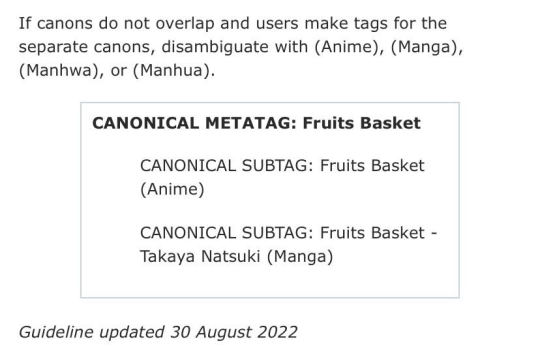
So, I guess the tag wrangler(s) for Fruits Basket consider the manga and the (unspecified which) anime to... not overlap? Or not overlap enough? Again, this confuses me. The 2019 anime covered all of canon and only had extremely minor changes, and those were mostly done just to make it work better in animation instead of print. The 2001 anime only covered the first third or so of the story and had some bigger changes, but nothing outside the realm of what a fan might change in a fanwork for the manga.
So, what do I think would be the best outcome for the Fruits Basket media tags on Ao3?
When I think about it, I could see people who had only seen the 2001 anime benefiting from being able to search only for works relating to the 2001 anime. And I could see people who have read the manga/seen the 2019 anime being annoyed if the major changes of the 2001 anime were referenced on works tagged to the manga/2019 anime. But I can't really see that happening between the manga and the 2019 anime. Those changes were so minute, I doubt they'd be relevant most of the time.
So, with the caveat that I'm only one user, and I don't know for sure if my opinion is the one held by most users in the Fruits Basket fandom, here are some potential solutions that would work for me & (I believe) for most users in the Fruits Basket fandom:
bring back "Fruits Basket" as a metatag for all 3 media types, or
make the manga tag synonymous with the 2019 anime, with the new canonical reading [Fruits Basket (Anime 2019 & Manga)], and make the 2001 anime a subtag of that new combined tag, or
make both anime tags subtags of the manga tag
Anyway, if you wanted to know what I've been doing instead of writing over the past few weeks, this is it. 😅 I'd really love to hear what you think of my proposed solutions, and if the change caused problems for you as it did for me, or if it actually made things easier.
Info about another tag wrangling issue for Fruits Basket coming soon in a separate (much shorter!) post!
#fruits basket#furuba#fruba#fanfic#ao3#poll#poll results#tumblr polls#my polls#canonical tags#metatags#ao3 tags#fandom tags#ao3 fandom#fanfic readers#fanfic authors#problem solving#tag wrangling#sort of#i am not a wrangler#but i'd like to be!#anime & manga#all media types#by cinderella-ish#my post
11 notes
·
View notes
Text
So apparently "Time Travel" and "Alternate Universe - Time Travel" are not metatags??? Neither falls under the umbrella of the other???? They are not equivalent????????
What?

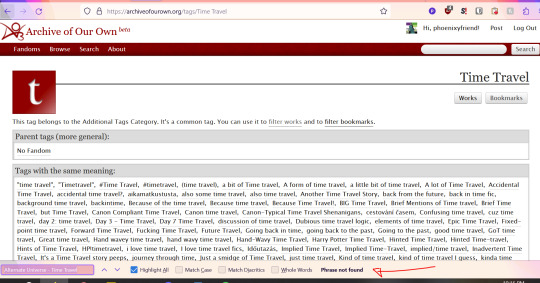
#ao3#tagging#metatags#time travel#tag wranglers pls explain???#ftr I was trying to find itstimeforstarwars's fic
53 notes
·
View notes
Text

Expand your reach and grow your business with world-class SEO services. Partner with us. https://seoresellerscanada.ca/seo/on-page-optimization/
#GrowYourBusiness#WorldClassSEO#SEO#OnPageSEO#SearchEngineOptimization#DigitalMarketing#ContentOptimization#KeywordResearch#MetaTags#WebsiteOptimization#TechnicalSEO#SEOStrategy#ContentStrategy#SEOTools#GoogleRanking
2 notes
·
View notes
Link
Meta tags are text snippets that help to describe the content of a web page. Learn more.
3 notes
·
View notes
Photo

How can a business stay ahead of the competition? It’s simple. They need to ensure they are getting their message across to the right people at the right time using SEO and other online marketing strategies. Where Brandon Lederer Arizona has an excellent team of specialists who will help you get your content to reach a greater audience. https://www.brandonlederer.me/
#digitalmarketing#marketing#socialmediamarketing#seo#business#branding#advertising#keywords#contentmarketing#backlinks#visibility#digitalmarketingagency#metatags#marketingtips#smallbusiness#digitalmarketingtips#website#onlinebusiness
4 notes
·
View notes
Text
Mastering Meta Tags for SEO Success

It is important that you optimize your web pages for some keywords which are referred to as meta tags which can help improve your rankings on the search results page. These HTML elements are used by search engines to crawl the web sites and make your sites easily discoverable. Here’s a quick guide to optimizing your meta tags:
1.Title Tags:
Keep them between 50-60 characters.
Include strategic keywords and your brand name.
Craft engaging, human-friendly titles.
2.Meta Descriptions:
Aim for 150-160 characters.
Integrate relevant keywords.
Write compelling, original copy with a call-to-action.
3.Image Tags (Alt Text):
Use keywords to describe images.
Prioritize alt text for key images.
Use descriptive file names.
4.Header Tags (H1 to H6):
Include keywords in headers.
Avoid generic names like “chapter 1.”
Keep a consistent, engaging tone.
Optimizing these tags is crucial for ranking higher on Google and increasing your click-through rates.
Read more: Guide To Meta Tags For SEO.
#SEO#MetaTags#DigitalMarketing#SearchEngineOptimization#WebsiteOptimization#GoogleRanking#ContentMarketing#SEOtips#OnlineVisibility#WebDevelopment
0 notes
Text
Openhouseperth.net Insurance: Why You Should Choose It
When it comes to protecting your most valuable assets, such as your home, choosing the right insurance provider is paramount.
Click here:
0 notes
Text
SEO basics course
If you're new to search engine optimization and want to build a strong foundation, the SEO basics course at Digi Code Nexus is the perfect starting point. This course introduces you to essential SEO concepts, such as keyword research, on-page optimization, and meta tags. You'll also learn about the importance of content quality and site structure in achieving higher search engine rankings. With Digi Code Nexus, you'll receive expert guidance and hands-on practice to solidify your understanding. Join our SEO basics course to kickstart your journey into the world of SEO and set the stage for a successful digital marketing career.

#SEOBasics#DigitalMarketingCourse#KeywordResearch#OnPageOptimization#MetaTags#ContentQuality#SiteStructure#SEOTraining#BeginnerSEO#DigitalMarketingCareer
0 notes
Text
Mastering meta tags for search optimization?
Mastering meta tags for search optimization? Here's how: Aim for concise 155-160 characters, craft clear and compelling sentences, and strategically include one or two keywords. Elevate your SEO game with effective meta tags!
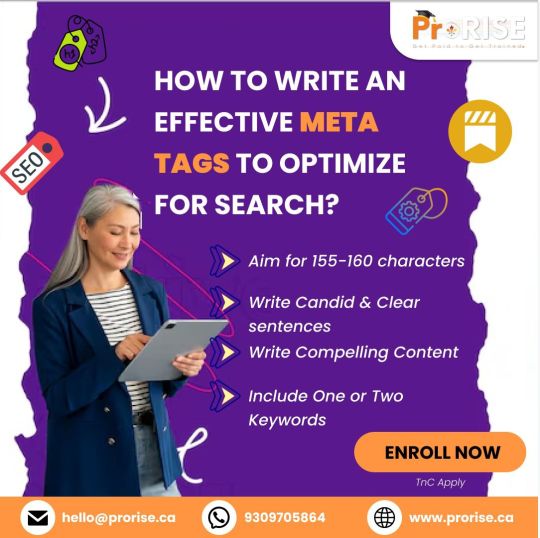
#prorise#SEO#MetaTags#SearchOptimization#DigitalMarketingTips#MetaTagOptimization#SEOStrategy#EffectiveMetaTags#KeywordInclusion#ClearContentWriting#OptimizeForSearch#MaximizeVisibility#OnlineCourseAvailability
1 note
·
View note
Text
🔵 3 ventajas en negrita de la promoción del sitio SEO regional 🔵
La promoción regional del sitio SEO tiene varias ventajas que pueden beneficiar a tu negocio si se utiliza de manera efectiva.

Algunas de estas ventajas son:
Atracción de tráfico local: Al dirigir tu estrategia SEO a una región específica, puedes atraer tráfico local relevante para tu negocio. Esto aumentará la probabilidad de conversión, ya que estás llegando a personas que se encuentran físicamente cerca de tu empresa.
Ejemplo: Si tienes una tienda de ropa en Barcelona, puedes optimizar tu sitio web para palabras clave relacionadas con la moda en esa ciudad. De esta manera, atraerás a personas que buscan tiendas de ropa en Barcelona y aumentarás las posibilidades de que visiten tu tienda física. La atracción de tráfico local es clave para las empresas que operan en un área geográfica específica. Al centrarte en tu región, podrás competir de manera más efectiva con otras empresas locales y destacarte ante los consumidores potenciales de tu área.
Competencia menos intensa: Al enfocarte en la promoción regional, es probable que la competencia sea menos intensa que a nivel nacional o global. Esto te brinda la oportunidad de posicionarte más fácilmente en los resultados de búsqueda y aumentar tu visibilidad entre los usuarios locales.
Ejemplo: Si tienes una empresa de servicios de limpieza en Madrid, es probable que haya menos competencia para palabras clave relacionadas con este servicio en Madrid que a nivel nacional. Esto te permitirá posicionarte más alto en los resultados de búsqueda y captar la atención de los usuarios locales interesados en contratar tus servicios. La competencia puede ser feroz en el ámbito del SEO a nivel nacional o global, por lo que la promoción regional puede ser una estrategia más eficaz para empresas locales que buscan destacarse en su mercado.
Mejorar la relevancia y la personalización: Al adaptar tu estrategia SEO a una región específica, puedes mejorar la relevancia de tu sitio web para los usuarios locales. Esto aumentará la probabilidad de que los visitantes del sitio encuentren lo que están buscando y se conviertan en clientes.
Ejemplo: Si tienes un restaurante en Valencia, puedes optimizar tu sitio web para palabras clave relacionadas con la gastronomía valenciana y lugares de interés en la ciudad. De esta forma, los usuarios locales que buscan información sobre restaurantes en Valencia encontrarán tu sitio web más fácilmente y estarán más inclinados a visitar tu establecimiento. La relevancia y la personalización son aspectos clave del SEO que pueden mejorar la experiencia del usuario y aumentar la tasa de conversión. Al adaptar tu estrategia SEO a una región específica, podrás ofrecer contenido más relevante y personalizado a tus visitantes, lo que mejorará la percepción de tu marca y aumentará la fidelización de los clientes locales.
___________________________________________
❇️ ¡Hola! ¿Quieres que tu sitio web destaque en Internet? ¡Déjame ayudarte con mi promoción de SEO! Con mi experiencia y conocimiento en optimización de motores de búsqueda, puedo llevar tu sitio web a la cima de los rankings de Google. ¿Quieres aumentar tu tráfico, obtener más clientes y hacer crecer tu negocio en línea? ¡Entonces contáctame ahora y juntos hagamos que tu sitio web brille en la web! ❇️
#SEO#SearchEngineOptimization#DigitalMarketing#GoogleRanking#KeywordResearch#OnPageSEO#OffPageSEO#LinkBuilding#SEOStrategy#SERP#ContentMarketing#PPC#SEM#MetaTags#Backlinks#OrganicSearch#SEOTools#WebTraffic#MobileSEO#LocalSEO#EcommerceSEO#GoogleAlgorithm#WebsiteOptimization#SEOConsultant#SEOExpert#SEOAgency#local seo#seo company#seo marketing#seo services
0 notes
Link
#seo#digital marketing#keyword research#marketing#technical seo#offpage seo#onpage seo#websites designing#links#links buidling#seotags#metatags#google console#google#woocommerce#shopify#squarespace#wix#wordpress
0 notes
Text
"Responsive, dynamic, unforgettable – that's our design ethos."
#KeywordOptimization#ContentQuality#MetaTags#URLStructure#InternalLinks#HeaderTags#ImageOptimization#MobileResponsiveness#PageSpeed#UserExperience#StructuredData#ContentUpdates#AnchorText#CanonicalTags#301Redirects#SchemaMarkup#SocialInteg
0 notes
Video
The Ultimate SEO Guide Boost Your Website's Visibility and Rank Higher https://gmbmarketingsolutions.com/how-to-get-your-business-to-the-top-of-google-search-results/ When talking about SEO remember these best practices On-page optimization Include relevant keywords in your content URLs and meta tags make sure your website is mobile-friendly and loads quickly Quality content creation Consistently publish content that satisfies your audience's needs utilizing keywords to boost visibility. Watch the full video here https://www.youtube.com/watch?v=y6ELCOPqm9k , , , , , , , , , , , , , , , , , , ,
#OnPageOptimization#RelevantKeywords#ContentURLs#MetaTags#MobileFriendly#QuickLoading#QualityContentCreation#AudienceNeeds#KeywordVisibility#SEOGuide#WebsiteVisibility#RankHigher#SEOTips#DigitalMarketing#OnlineVisibility#ContentCreation#SEOBestPractices#WebsiteOptimization#GoogleRanking#SEOSuccess
0 notes
Text

On-pageSEO requires a lot of work and time to get results. Industry experts must devise the right strategy, and SEO Resellers Canada can help. https://seoresellerscanada.ca/seo/on-page-optimization/
#SEO#OnPageSEO#SearchEngineOptimization#WebsiteOptimization#DigitalMarketing#ContentOptimization#MetaTags#KeywordResearch#PageRank#SERP
1 note
·
View note
Text
What are the benefits of utilizing meta tags for SEO?
SEO and digital marketing have created a distinctive space in the digital world. While attempting SEO tasks, utilizing meta tags for SEO is one of the main things professionals take care of. Meta tags are HTML tags that help search engines and website visitors understand the content of your page. Meta tags occur solely in the page’s code. They can be checked using the source code (Ctrl+U). In short, meta tags are important elements for all search engines that exist in the HTML code of a website page. They inform the search engine about the page’s content. They are the first impression and point of contact for all search engines. Meta tags are inserted into a portion of an HTML web page and are used to “legally” hide words on your pages from search engines.
Every platform has a distinct method for inserting meta tags, much as WordPress offers free plugins to pick from. Some SEO and digital marketing experts recommend the All-in-One SEO Pack and the Yoast SEO plugins. Both are popular, and you can select one based on your needs. Always try to avoid mistakes while using SEO.

Meta Tags Unmasked:
Meta tags are like superhero costumes for websites, preferred by all SEO and digital marketing experts. They’re hidden codes that tell search engines about a webpage. Just as superheroes wear unique outfits, websites have meta tags that define their identity. These digital costumes include details like titles, descriptions, and keywords. Meta tags play a vital role in helping search engines understand and categorize a website’s content.
Decoding meta tags is like unveiling a superhero’s true identity. It exposes the inner workings that boost a website’s visibility and recognition online. Utilizing meta tags for SEO is an important part of web presence that many may find mysterious, but understanding it is like peeling back the layers of a superhero’s costume to reveal the essence within. Ultimately, there is no chance that you can afford to neglect meta tags.
Boosting Visibility: The Invisible Cloak of Meta Descriptions
Meta descriptions are like invisible cloaks for websites, drawing in search engine users. Just as an invisibility cloak hides its wearer, meta descriptions conceal the content within a webpage. It entices users to click. They are concise summaries that appear in search results. It gives a sneak peek into what a page offers. SEO and digital marketing professionals use it as a tool to enhance their SEO game.
Imagine a magical cloak that captures attention—that’s what compelling meta descriptions do for websites. It’s the art of crafting these invisible cloaks that makes a difference, turning casual browsers into engaged visitors, all with the magic of well-crafted meta descriptions.
Title Tags-The Captain America Shield of Search Results:
Title tags act as the Captain America shield for your website in the vast landscape of search results. Just like Captain America’s shield protects against threats, optimized title tags guard your website from obscurity in search engine rankings. These tags are the first things users see in search results, making them crucial for grabbing attention and encouraging clicks. The title tag is your digital shield, ensuring that your website stands out and defends its place in the competitive realm of search engine visibility. It is the best way of utilizing meta tags for SEO on your website.
Click here to get more insights
0 notes
Text
The Value of SEO-Friendly Structure: Increasing User Experience
A website that ranks highly on search engine results pages and offers an enjoyable experience for users is essential in today's digital world, where competition is intense and attention durations are short. A key factor in reaching this precise balance is setting in place an SEO-Friendly structure. The structure of your website can be made both user- and search engine-friendly, which will greatly improve user experience and improve results.

An SEO-Friendly structure, most importantly, makes sure that search engines can properly crawl and index your website. To understand the significance and context behind every page on your website, search engine crawlers depend on a well-structured content structure and easy navigation.
You may facilitate search engines' understanding and proper ranking of your pages by using headings, meta tags, and logical content organisation into groups.
Additionally, a well-structured website improves the user experience by improving visitors' search for content. When visitors arrive at your website, they want an easy navigation experience and a fast search for the right data. Product pages, blog entries, and informational resources may all be quickly found and accessed by users with the help of a well-structured website.
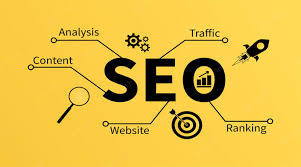
Mobile accessibility is a critical component of an SEO-Friendly system. It's essential to make sure your website is mobile-friendly, as the number of people using smartphones and tablets rises. A responsive design offers customers an identical look and feel across devices by fluidly adjusting to varying screen sizes and resolutions. In addition to improving user experience, giving mobile optimization top priority increases your site's exposure in mobile search results, which is a significant consideration for search engines like Google.
Additionally, internal linking—which is essential for distributing link equity throughout your website—is made easier by an SEO-Friendly layout. Important sites can receive authority and relevance signals from well-placed internal links on your website, which will increase their exposure and search engine ranking. Internal linking also facilitates deeper navigation and related content discovery for users, which raises engagement and lowers bounce rates.
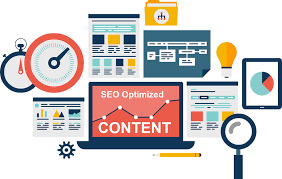
In addition to being technically sound, an SEO-Friendly structure improves user experience by promoting consistency and transparency in navigational design. Users are more likely to remain longer, investigate more, and eventually convert when they come across a website that is well-organised and easy to use. On the other hand, users may become frustrated by a cluttered or unclear website structure, which can result in high bounce rates and missed chances.
For more Information Visit our Website = Apna Laptop
#seo#search engine#DigitalMarketing#OnlineMarketing#SEM (Search Engine Marketing)#ContentMarketing#KeywordResearch#LinkBuilding#SERP (Search Engine Results Page)#OnPageSEO#OffPageSEO#SEOStrategy#SEOTools#GoogleRanking#WebsiteOptimization#MetaTags#Backlinks#SEOAnalysis#LocalSEO#MobileSEO
0 notes